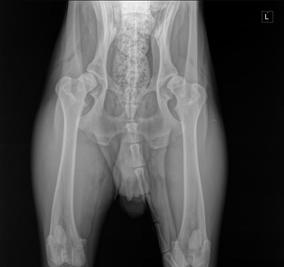***Oak Glen German Shepherds ***
Yucaipa, California
Hearing so many concerns over the issue of hip dysplasia in the German Shepherd breed over the two decades I spent raising and working with this magnificent breed has bought me to address and clarify(by my research of bloodlines and with help of some very knowledgeable veterinarians and world class breeders of the GSD)I would like to share some important facts...
Myth #1
All sloped and angulated GSDs will be prone to hip issues.Straight backed Shepherds are the type that are dysplasia free.
Truth:
Conformation has nothing to do with the way the hip forms in the socket.It is actually the sloped West German Showline bloodlines that are most thouroughly screened (A stamped)in Germany to keep producing healthy strong hips and elbows.
Myth #2
Hip Dysplasia is always Genetically caused.
Truth:
The bulk of the hip dysplasia disorder is genetic. However, environmental factors can play a role in the development and severity of hip dysplasia. Improper nutrition, trauma, and abnormal growth during the time the bones are developing are factors that can contribute to the development of hip dysplasia. The higher the genetic load (having a higher number of defective genes) within a dog, the less environmental factors are needed to result in the formation of hip dysplasia. The lower the genetic load, the greater environmental factors the dog can handle.
Early spay/neuter(under age 1)has recently been link to cases of severe hip dysplasia.The hormones produced during growth are crucial to proper joint formation.
Myth #3
All German Shepherds have bad hips/Will get hip dysplasia as they age.
Truth:
If anyone owns a German Shepherd, they will undoubtedly hear this statement from other people who know little about the breed (or who think they know a lot about GSDs because they had one, once). People often witness the angulation of the rear legs and the motion of their walk, and assume that the dog has hip dysplasia, even when the dog does not. This is “verified” by many of the overbred American and German show line dogs, who may have such severe angulation that it creates a very odd “frog-like” walk. This is created by the change in the length of the stifle and the positioning of the croup, not necessarily by the morphology of the hip joint itself. These dogs may still show normal hips via x-ray, and in fact many of them do have “a” normal hips. But the difference in their structure and the way they move has created this myth that “all GSDs have bad hips.”
German Shepherd Dogs will not suddenly “develop” hip dysplasia as they age. They may get arthritis in their hips or in the lumbosacral region of the spine, but this is not to be confused with dysplasia (malformation of the actual hip joint). Many people believe their dogs have “good hips” (not verified by x-ray), when they may actually have mild or moderate dysplasia that starts revealing itself as the dog hits six, seven, or eight years of age. The laxity of the hip joint and the improper fit of the ball and socket have created arthritic changes that now are manifested as pain, stiffness, and uneven muscle development as the dog alters its gait to protect the most painful joint. Arthritis develops over time, until it finally is painful enough for the dog to show it. Thus, the arthritic changes began years ago, created by the poor morphology of the hip and the excessive laxity (looseness) that has allowed the bones to bump and grind and move excessively. But since this does not show until the dog ages, the belief becomes that the dog “developed bad hips in old age”. In reality, the dog has always had bad hips, but is just now showing it. A dog with good, tight hips will age better with much less arthritis overall; there are many GSDs with good hips who are still running and jumping and even working well into their golden years!
The truth of the matter is that anyone wishing to breed their dog should x-ray both hips and elbows first and certify them with OFA or the SV, to conclusively prove that their dog is free of hip and elbow dysplasia. And puppy buyers should ensure that their potential breeder has valid hip and elbow certificates for their dogs. Hip ratings can be checked on the OFA database; if a breeder’s dogs do not show up in the database, ask to see proof of valid hip ratings.
Myths And Facts About Hip Dysplasia
